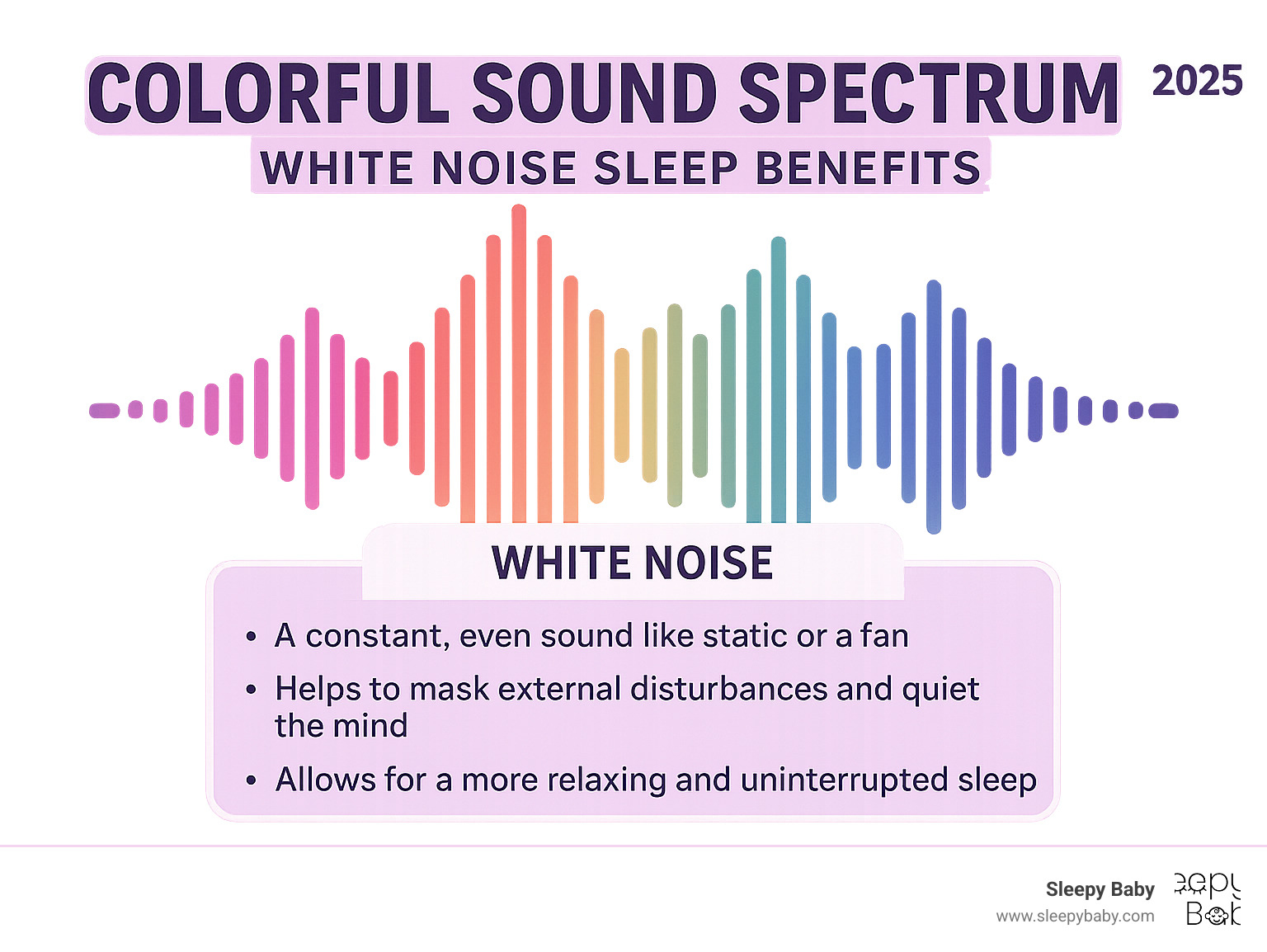The Power of White Noise for Restful Sleep
What is White Noise and How Does It Work?
So, what exactly is this "white noise" we keep talking about? At its core, white noise is a blend of all audible frequencies played at the same intensity—think of the static from an untuned radio or the steady hum of a fan. Because every pitch is present, no single tone stands out, so your brain quickly labels it “unimportant” and tunes it out.
This uniform backdrop masks sudden environmental sounds—a door slam, a car horn, a midnight snore—by raising your "arousal threshold," making you less likely to wake up. A study of New York City adults struggling with street noise found that adding white noise significantly improved their sleep quality, even in a city that never seems to quiet down. Scientific research on noise masking in NYC
For newborns, the benefit is even clearer. Life in the womb is surprisingly loud; blood flow and a mother’s heartbeat can reach 70–90 dB. White noise mimics this constant whoosh, offering a familiar cue that calms fussiness and shortens the time to sleep. Find more in our blog: Womb Heartbeat White Noise: Your Baby's Favorite Soundtrack.
The Science of Sound Masking
Our brains treat sudden changes in sound as possible danger. By filling the silence, white noise smooths out the peaks between “background” and “intrusion,” so a barking dog or creaking floorboard no longer jolts you into full alertness.
Why It Helps Quiet a Racing Mind
Silence can amplify internal chatter. A steady, monotonous hum gives your brain something neutral to focus on, gently nudging intrusive thoughts to the background. Over time, turning on white noise before bed becomes a powerful psychological cue that says, “Sleep time starts now.”
The Core White Noise Sleep Benefits for Adults and Babies
Research shows that white noise doesn’t just help you doze off—it improves the quality and continuity of sleep. Hospitals, shift-worker sleep labs and urban apartments have all reported fewer awakenings when a constant sound blanket is used.
Proven white noise sleep benefits for falling asleep faster
Reducing "sleep latency" is where white noise really shines. One laboratory study found that adults fell asleep 38% faster when it was playing. For infants, the effect is dramatic: 80% of newborns in one trial nodded off within five minutes of hearing white noise, versus 25% without it. Parents can find more tips in Dreamland Awaits: Your Guide To Infant Sleep Aids.
Key white noise sleep benefits for staying asleep longer
The same masking effect that speeds up sleep onset also keeps you there. By reducing “wake after sleep onset” and buffering against traffic, snoring partners or early-rising birds, white noise supports deeper, more restorative sleep cycles and better overall sleep efficiency.
A Spectrum of Sound: White Noise and Its Variations

“White noise” is just one colour in a whole rainbow of sounds. By tilting the power toward higher or lower frequencies we get pink, brown, blue and other hues—each with its own feel.
| Noise Color | Sound Description | Frequency Characteristics | Common Uses |
|---|---|---|---|
| White Noise | Radio static, a whirring fan | Equal power across the spectrum | Sleep, masking environmental noise, focus, soothing babies |
| Pink Noise | Steady rainfall, rustling leaves | Power decreases 3 dB per octave | Deep sleep, memory, relaxation |
| Brown Noise | Distant thunder, ocean surf | Power decreases 6 dB per octave | Relaxation, focus, possible ADHD or tinnitus relief |
| Blue Noise | Hissing water spray | Power increases 3 dB per octave | Tinnitus masking, audio testing |
| Violet Noise | High-frequency hiss | Power increases 6 dB per octave | Tinnitus relief |
| Grey Noise | Balanced across human hearing | Psycho-acoustic curve | Audio testing, some sleep tools |
Gentle Variations: Softer and Deeper Sounds
Many sleepers prefer the warmer tones of pink or brown noise because the sharper high frequencies are softened. Studies suggest pink noise can even boost deep-sleep duration and memory consolidation. Research on sound variations and deep sleep
Other Sound Profiles
Blue, violet, grey and even the niche “green” or “orange” noises have specialised uses, but for most people a quick experiment with white, pink and brown is enough to find a personal sweet spot.
How to Safely and Effectively Use White Noise
You’ll get the most from white noise by treating it like any other part of good sleep hygiene—use the right volume, place the speaker wisely, and make it a nightly cue. If you’re shopping for a device, our Ultimate Checklist For Choosing The Best Baby Sleep Machine covers the must-haves for both adults and infants.
Finding the Right Volume: Decibel Recommendations
- Adults sleep well at around 46 dB; keep nightly exposure below 70 dB to protect hearing.
- The CDC considers 85 dB unsafe for prolonged listening.
- Infants need extra caution: keep the device at least 7 ft (2 m) from the crib and under 50 dB—about the volume of a gentle shower. Study on infant sound machine volume
Incorporating White Noise into Your Bedtime Routine
Turn the sound on 15–30 minutes before lights-out, combine it with a calming activity (reading, stretching, a warm bath) and keep the room cool, dark and comfortable. Continuous play blocks bumps in the night; a 60–90-minute timer works if you prefer silence later. Consistency is what trains your brain to link the sound with sleep.
Beyond the Bedroom: Other Practical Uses for White Noise

White noise isn’t just a lullaby—it’s a productivity and privacy tool, too. Studies have shown that a moderate level (50–70 dB) can improve cognitive performance and lower stress in busy environments. Research on cognitive performance and stress
Improving Focus and Productivity
In open offices or coffee shops, a steady hum masks keyboard clatter and chatter so your brain can stay on task. Some people with ADHD report better sustained attention as well.
Enhancing Privacy
Therapy rooms, clinics and shared apartments use white noise as a “sound curtain” to keep conversations confidential.
Relief for Tinnitus Sufferers
For those hearing an internal ringing, external white noise can mask the perception and make the symptom less intrusive, especially at night.
Frequently Asked Questions about White Noise
Can you become dependent on white noise for sleep?
You can form a habit, much like needing a favourite pillow, but not a physical addiction. If you want to stay flexible, rotate between different sounds, use a shut-off timer, or take occasional breaks when the environment is naturally quiet.
Are there any risks or downsides to using white noise?
The main risk is hearing damage from volumes above 70 dB, especially for babies whose machines are sometimes placed too close. Keep levels low and distance adequate. Research on long-term effects is mixed, but most studies show benefits outweigh risks when volume is controlled. A systematic review on noise as a sleep aid
What's better for sleep: white noise or complete silence?
It depends on your environment and personal preference. Silence is ideal in truly quiet spaces. In real-world settings with sporadic noise—or for anyone whose mind races in silence—white noise provides a consistent backdrop that prevents sudden disturbances.
Conclusion
We've journeyed together through the incredible world of white noise, finding how this simple sound can be a true game-changer for restful sleep and so much more. From its scientific roots as a blend of all audible frequencies to its profound impact on our daily lives, the white noise sleep benefits are truly remarkable.
At its heart, white noise acts like a gentle guardian, masking those sudden, jarring sounds that love to interrupt our slumber. It helps us drift off faster, enjoy fewer nighttime awakenings, and even quiets that busy mind that sometimes won't switch off. Whether you're an adult navigating a noisy city, a shift worker trying to catch Zs during the day, or a parent soothing a fussy baby by mimicking the comforting sounds of the womb, white noise offers a consistent, peaceful accept.
But its magic isn't confined to the bedroom! White noise is a versatile tool for modern life, empowering us to focus better in distracting environments, adding a layer of privacy to sensitive conversations, and providing much-needed relief for those dealing with tinnitus. And remember, sound is colorful – exploring variations like the deep, soothing tones of pink and brown noise can help you find your perfect auditory comfort zone.
Crucially, we've learned that safety, especially for our little ones, is paramount. Keeping the volume low and the placement thoughtful ensures that the benefits outweigh any potential risks. Our goal at Sleepy Baby has always been to empower you with the knowledge and tools to achieve better, more independent sleep, not just for your children, but for you too.
For parents seeking these profound advantages for their little ones, Sleepy Baby's intelligent sleep aids are designed to make bedtime a dream. We combine soothing white noise with rhythmic patting, carefully mimicking a caregiver’s comforting touch. This creates the perfect sleep environment, offering hands-free, customizable soothing for babies and much-needed support for caregivers across Australia, Canada, the United States, the UK, and many other countries. As your baby grows and their sleep needs evolve, we're here to help you steer every stage of their sleep journey. Find more about optimizing your little one's rest in our guide: Mastering the 6-Month-Old Sleep Schedule. Here's to sleeping soundly and living fully!




